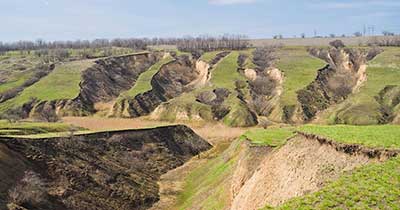Relevance: GS-3: Agricultural produce and issues and related constraints
Key phrases: crop-insurance premiums, Soil Health Card scheme, N:P:K ration, Soil-friendly” food labels
Why in News?
- Soil creates life from death. The production of more than 95% of the food we eat relies on soil, a heady mix of rock particles, decaying organic matter, roots, fungi and microorganisms.
- This precious resource is eroding at a global average of 13.5 tonnes per hectare per year.
- Instead of nourishing crops, fertile topsoil is ending up in inconvenient places such as ditches, reservoirs and the ocean, raising serious questions on future food security.
Current status
- Soil can be created over time, as dead things break down and contribute energy and nutrients to an ecosystem based on the underlying rock. But it erodes 10–30 times faster than it is produced.
- Globally, soil erosion reduces annual crop yields by 0.3%. At that rate, 10% of production could be lost by 2050.
- In erosion hotspots such as Nigeria, 80% of the land has been degraded.
- In Iowa, up to 17% of land is almost devoid of topsoil. Almost more convincing than the many facts and figures is a colour photograph of a field in Iowa with so little topsoil that the pale, lifeless sandy rubble.
Solutions Suggested
-
Age-old solutions:
- Planting diverse crops in rotation.
- Increasing organic content with additions such as compost and biochar(Biochar is a charcoal-like substance that’s made by burning things like agri-waste also called biomass, in a controlled process called pyrolysis).
- Reducing the erosional effects of water and wind by reshaping the land with contouring, terraces, windbreaks and the like; and
- Ploughing should be gradually reduced.
-
Learning from best practices: Diverse soil-management techniques
- Scottish Islands: Deep black “plaggen” soils on the islands, made rich with cattle manure.
- Philippines: Rice terraces managed for 2,000 years by the Ifugao people in the Philippines with a traditional approach.
- Latin America: The milpa farming system of the Maya in Latin America, with its 25-year rotation of crops including trees has improved soil fertility multiple times.
- New Zealand: Use of compost made of seaweed, shells and plant material by the Māori community for reducing soil erosion.
- Each system yields rich agricultural productivity while maintaining deep banks of carbon-rich, fertile soil.
-
Top-down overhaul
- Incentives for increasing carbon in the soil: Propose discounts on crop-insurance premiums or income transfers for farmers who increase the carbon in their soil.
- Case study United States:
- In the United States, farmers can apply for funding for anti-erosion improvements through the Environmental Quality Incentives Program, run by the Department of Agriculture.
- Funding announced this month will increase the amount of land planted with cover crops to 12 million hectares by 2030.
- But even that would represent only some 7% of US cropland. It is not enough.
- Case Study India:
- The Soil Health Card scheme was introduced to improve soil fertility.
- Scheme helped many farmers to adopt soil friendly techniques.
- N:P:K ratio further improved.
Editor’s Opinion: Why is fertile soil being allowed to wash and blow away?
- Farming’s profit margins are razor-thin, forcing producers to plant the highest-yielding variety of the highest-profit crop from field edge to field edge every season.
- Terracing, rotating crops and forgoing tilling that enriches soil are compromised for profits every year.
- A vicious cycle started: farmers can’t pay their mortgages, further intensifying inputs for surplus productivity.
Way Forward
- Multiple Level Planning: Burden of protecting soil cannot be relegated to indigenous people and environmental activists. Multiple level planning through integration of all efforts are needed.
- Need for international soil treaties, on the line of climate treaties.
- Costly Penalties but based on principles like justice and fairness: Countries seem likely to both under-promise and under-deliver unless there are costly penalties for failure.
- Soil-friendly” food labels: For the consumers' awareness of food produced on farms that are working to improve their soil. Similar labels have put a meaningful dent in climate change or other environmental problems - and many customers will prefer to spend more on “soil-friendly” food.
- Promote private entrepreneurs: Farming began to move towards a model in which farmers are less independent, entrepreneurs growing and selling food, and with government support managing a complex mix of food production, soil fertility, wildlife habitat and more.
- Specific programmes for soil conservation: Around the world, many farmers depend on subsidies, drought relief and payments from piecemeal schemes to conserve soil and nature. Such programmes — currently small-scale, ad hoc fixes for a broken system — should be the core of the agricultural sector.
Conclusion
- Our land, our fresh water, our biodiversity and our soil are too precious to be destroyed by the market price of commodity grains and other foodstuffs.
- We must invest deeply and thoughtfully in our farmers so that they can invest deeply and thoughtfully in the land, becoming holistic landscape-management professionals. This is the future of farming.
Mains Question:
Q. Since independence, India’s efforts on soil conservation have been very ad hoc and myopic. Critically examine this statement with special emphasis on National Mission on Sustainable Agriculture.( 15 marks)
Source: NATURE







